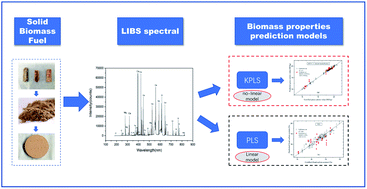The rapid analysis of fuel properties is important for the utilization of solid biomass due to its great variation in feedstock. Laser-induced breakdown spectroscopy (LIBS) technology combined with quantitative analysis models can be used for this analysis. Most existing prediction models used in LIBS for fuel property analysis are linear methods, such as the partial least squares (PLS) model, which fail to reflect the non-linear relationships between the LIBS spectrum and the fuel property index being predicted. In the present work, LIBS data combined with a kernel partial least squares (KPLS) method are used to analyze the gross calorific value, and the volatile matter, ash and fixed carbon content of the solid biomass fuel. Quantitative analysis performance of the KPLS model was compared to that of the widely used PLS method, with the results showing some improvements. The KPLS model was further improved using three data normalization methods (i.e., C internal standardization, total intensity standardization and standard normal variate). The best quantitative analysis results of the volatile matter and ash content were obtained when the KPLS model was combined with C internal standardization, with root mean square errors of prediction (RMSEP) of 1.365% and 0.290%, and average standard deviations (ASD) of 0.277% and 0.080%, respectively. The best quantitative analysis results of the gross calorific value and fixed carbon content were obtained when using KPLS without normalization. The RMSEP and ASD of the gross calorific value and fixed carbon content were 0.198 MJ kg−1 and 0.746%, and 0.070 MJ kg−1 and 0.111% respectively.
